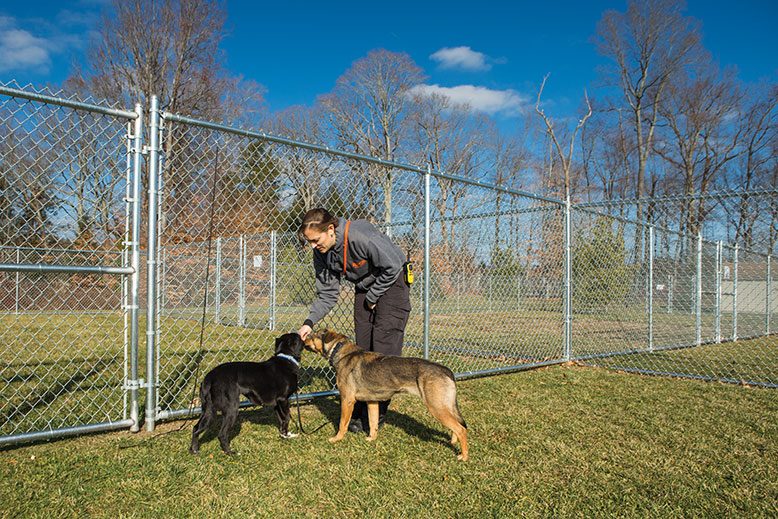
When she arrived at the Madison ASPCA center in September, Mabel, a mottled brown shepherd mix with sad eyes and soft fur, was paralyzed with fear. She remained immobile and crouched in the corner of her kennel run, trembling whenever anyone approached. When the trainers tried to coax her out, she was unable to interact.
Like many dogs in her situation, it looked as though Mabel was doomed to languish in a shelter, or be euthanized.
Mabel had been rescued from an animal shelter in Alabama that was shut down after allegations of abuse. More than 300 animals were removed from the shelter. Many, including Mabel, had been neglected and mistreated.
Now, after about 10 weeks of painstaking rehabilitation by experts at the ASPCA’s Behavioral Rehabilitation Center in Madison, Mabel is able to walk on a leash and take treats from a stranger’s hand. She even kisses her trainer.
Launched in March 2013, the Madison center is the only facility of its kind in the country dedicated to providing behavioral rehabilitation for former strays and dogs that have been victims of cruelty. Some have been confiscated from puppy mills. Others have been subjected to dog fights and other abusive situations.
“Once we started, we realized that the dogs we didn’t think would recover would make these amazing changes,” says Kristen Collins, an animal behaviorist and senior director of the center. “It’s surprised us how well the dogs have been doing and how relatively quickly they’ve been able to be adopted. We thought we’d have a 50 percent success rate with these dogs; it’s been closer to 90 percent.”
Only physically healthy but fearful, behaviorally damaged dogs that have been rescued are eligible for treatment at the center, located within St. Hubert’s Animal Welfare Center. The intensive rehabilitation program focuses on contact with human trainers and fellow canines and on acclimating the animals to sights and sounds they may fear. Once the dogs graduate, they are transferred to partner shelters, including St. Hubert’s, for placement. (Those that cannot be helped are humanely euthanized.)
“We’re trying to give these dogs behavioral tools to help them explore the world,” says Collins, a Georgia native who lives in Madison. “We’re teaching them that petting feels good. And we’re teaching them how to encounter new things, so that if they see something new and potentially scary, they can shake it off and move on. We’re not trying to make them perfect; we want to help them function as companion animals and have a good quality of life.”
Some of the dogs have been so badly abused that they can’t be handled at all; others are just undersocialized and neglected. They bark and thrash around when someone tries to touch them. Others start shaking in their kennels when someone approaches. On the day this reporter visited, one of the dogs was catatonic. About 30 dogs can be treated at a time at the center, which has individual indoor/outdoor kennels, outdoor play yards, indoor treatment areas and wooded trails.
The center started as a pilot program, explains Collins, who previously worked on an anti-cruelty behavior team for the ASPCA, assessing dogs that had been victims of cruelty.
“There were always dogs that couldn’t be adopted,” she says. “They were afraid of everything. They couldn’t be walked on a leash or be near people. They didn’t know how to be petted…. They just didn’t know how to be dogs.”
So the New York-based ASPCA proposed a treatment center for these special cases. St. Hubert’s allowed the ASPCA to build the center at their facility. Since then, the center has successfully treated more than 200 dogs.
Ozzy, a 2-year-old Australian shepherd mix, is one of the center’s graduates. He was rescued from a hoarding situation in Wisconsin, where he was discovered living with 15 other dogs amid feces, trash and rotting food in a poorly ventilated mobile home. The dogs were withdrawn and anxiety ridden. Six of them, including Ozzy, were sent to the rehab center for treatment.
Ozzy was one of the most fearful dogs to enter the center. It took him weeks to feel comfortable enough to eat in the presence of the staff. He was frightened of human touch and of being put on a leash, and constantly attempted to escape by climbing walls or darting through doors. After four months of intensive treatment, Ozzy overcame his fears and could be taken for walks and petted. He graduated in February 2015 and was adopted through St. Hubert’s by an ASPCA volunteer, Jess Swanton, and her husband, Wayne. He is now enjoying life in Randolph with his new family, including two fellow rescue dogs. The family renamed him Ollie.
Swanton says it’s been particularly gratifying to adopt her new pet from the rehab center. “When they first brought him to the center, he was so aggressive that we were told we shouldn’t bother with him because he was a lost cause,” says Swanton. “They were so wrong. He’s such a happy dog now. You just need to come in the door…and he runs over and gives you kisses and nose bumps, and his tail is wagging.”
Most of the dogs take 12 to 14 weeks to graduate from the program, with some of the more severe cases taking as long as 20 weeks, says Collins, who has two dogs living in her office as part of their treatment. The center has a dedicated staff of trainers and experienced animal behaviorists as well as volunteers.
Because dogs are social and enjoy the company of other dogs, the trainers often enlist a dog that is further along to help with another dog’s treatment. On this fall day, two trainers take Mabel and her helper dog, Jazzy, a 2-year-old black-lab mix, outside for treatment. Both dogs are still skittish around strangers, but Jazzy is a little more advanced.
Lauren Zverina, a rehabilitation coordinator who lives in Chatham, and enrichment coordinator Katherine Good, of Hoboken, bring the dogs to a fenced, grassy area and remove their leashes. The dogs are cautious at first and won’t take a treat from either trainer. Mabel looks fine from a distance, but a closer look reveals signs of fear: her face is tense, her mouth clamped shut and her ears back. Neither dog wags its tail.
While Jazzy has greatly improved, she still has much to learn. “We’re trying to teach her to want to be near people,” says Zverina. “When Jazzy first arrived, she was highly anxious. She looked desperate to escape, jumping up on the walls, looking for a way out. She was very nervous about petting. When we gently stroked her, she’d stiffen, eyes huge and tail tucked.”
After a few minutes, the dogs start to relax. They each take some treats from the trainers and run around the pen. They let the trainers stroke them; they even seem to like it. Jazzy is less anxious and acts playful, frolicking with Mabel. Surprisingly, Mabel gives Zverina a kiss, and then another. The trainers laugh at this sign of improvement. Mabel happily rolls around in the grass, excited by a strange smell. The treatment, it appears, is working.
“I love watching them have happiness for the first time,” says Collins. “It’s an amazing moment.”
The rehabilitation program uses behavior-modification techniques such as desensitization and counter-conditioning to help the dogs shed their fears. The aim is to expose the animals to the things they’re afraid of at tolerable levels and create new, positive associations, says Collins.
Many of the dogs are afraid of people approaching, so the trainers break it down into baby steps, giving a dog a little food at a time while getting physically closer. The program teaches the dogs to enjoy gentle petting and to walk on a leash, among other things. The center has training rooms that are made to look like bedrooms and living rooms that the dogs would encounter in a home, with beds, couches, TVs and vacuum cleaners. These help the dogs adjust to living with families once they graduate.
The program has been so successful that the ASPCA staff is conducting a formal research study based on the techniques they are using with the dogs. (The ASPCA website has information for dog owners on dealing with common canine behavior issues.)
Back at the center in Madison, the staff is enthused to see dogs go home with new families. In fact, Mabel, who is four and has been renamed Belle, has graduated from the program and been adopted. The trainers provide advice to the adoptive families when the dogs come home and keep in touch about the dogs’ progress. Many of the families send pictures and videos to the former trainers.
“It’s rewarding for these adopters to rescue a dog coming from an abusive place,” says Collins. “It’s special to have a dog like that trust you. It can be very powerful.”
Jacqueline Mroz lives in Montclair with her husband and three children. They are getting closer to adopting a rescue dog.



